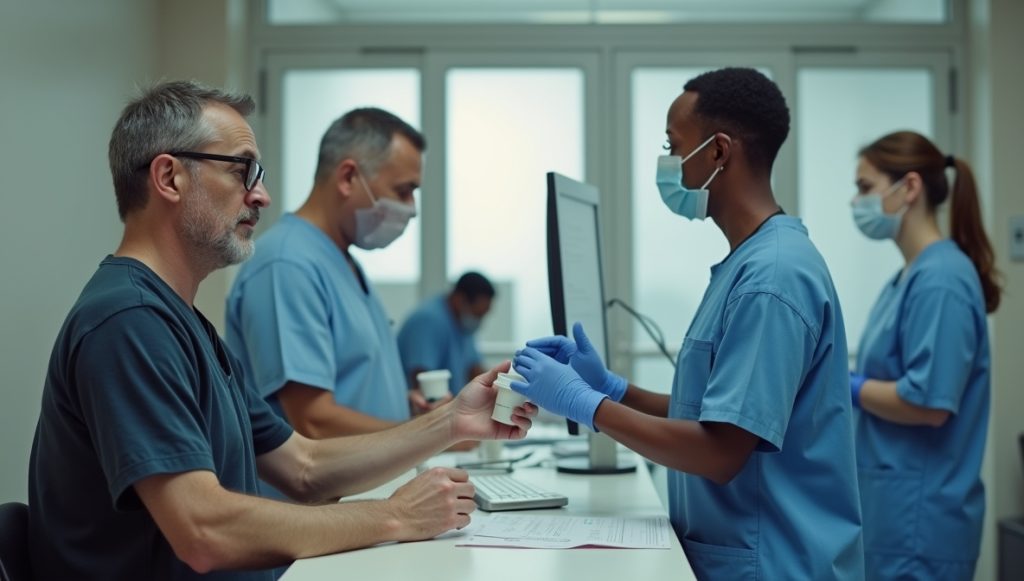In an age where workplace safety and productivity are pivotal, pre-employment drug screening has become a staple for many organizations across diverse industries. These tests are designed to detect the presence of drugs and, in some cases, alcohol in prospective employees. But the question that often arises is: do pre-employment drug screens test for alcohol? This guide will explore the intricacies of these screenings, their relevance in various sectors, and the implications for both employers and job seekers.
Key Takeaways
- Pre-employment drug screenings are increasingly common, and while they often test for drugs like THC and opioids, alcohol testing is not always included, depending on industry and company policies.
- Industries such as healthcare and transportation, where safety is critical, are more likely to conduct alcohol testing to prevent risks associated with impaired performance.
- The methods for drug and alcohol testing vary, including urine, mouth swab, and less commonly, hair tests, each with different detection capabilities and costs.
- Employers must create fair and transparent drug and alcohol testing policies, balancing legal compliance with considerations for employee privacy.
- Job seekers should be aware of the substances tested during screenings, prepare for potential outcomes, and understand their rights to ensure fair treatment throughout the hiring process.
Introduction
In today's competitive job market, pre-employment drug screenings are more common than ever. Companies want to ensure that they hire candidates who contribute positively to a safe and productive environment. These screenings are designed to check for the presence of drugs—and, sometimes, alcohol. This raises a crucial question: how often do these tests include alcohol, and why?
Alcohol testing in the hiring process is particularly relevant in sectors where safety and reliability are critical. In healthcare, technology, and hospitality industries, understanding whether alcohol is part of these screenings can impact both hiring policies and job-seeking strategies. This topic deserves a closer look, as it shapes the expectations and experiences of employers and prospective employees alike.

Understanding Pre-Employment Drug Screens
Pre-employment drug screens are a foundational part of the hiring process, serving a blend of purposes that align with business priorities like safety, compliance, and culture. Employers conduct these screens primarily to ensure that the workplace remains a safe and productive environment, reducing the risk of accidents that might be exacerbated by substance use. They also fulfill legal and regulatory mandates, especially in industries where mishaps can lead to significant ramifications.
Typically, these drug screens target a range of substances recognized for their potential to impair judgment or performance. Commonly tested substances include THC (the active component in marijuana), a variety of opioids (like heroin and prescription pain medications), and stimulants such as amphetamines and cocaine. Benzodiazepines and barbiturates often make the list as well, given their sedative effects.
These screenings reflect a snapshot of both the expectations set by employers and the legal landscape they operate within. The list of substances might vary, accommodating industry-specific requirements or shifts in societal norms regarding drug use. By understanding which substances are flagged and why, employers and job seekers can better align their actions with the overarching goal: fostering a safe and effective workplace.
Do Pre-Employment Drug Screens Test for Alcohol?
Alcohol Testing Overview:
Pre-employment drug screens may or may not include alcohol testing, largely depending on the employer's industry and policy. While drug tests commonly check for substances like THC and opioids, alcohol screening isn't always standard. Employers who do test for alcohol typically rely on breath or blood tests, although urine tests are possible. Companies prioritize this to prevent potential workplace issues linked to alcohol use, such as impaired performance or safety risks.
Industry Practices:
Different sectors have distinct approaches to alcohol testing. In the transportation industry, testing is stringent. DOT regulations mandate alcohol tests for commercial drivers to ensure public safety. Healthcare, similarly, demands high accountability, as impaired judgment can have severe consequences. Though not as common, some tech and retail companies may still test due to customer interaction and operational needs. Here, alcohol testing might focus on roles requiring vehicle use or handling sensitive data.
Relevance and Necessity:
While testing for substances like marijuana or harder drugs can predict chronic use, alcohol tests typically catch recent consumption. Debate persists on its necessity, as context matters; a positive result might not indicate regular misuse. Yet, in safety-critical roles, even minor consumption can pose risks. Employers often weigh the implications against costs and invasiveness before integrating alcohol screening into their protocols.
Types of Drug and Alcohol Tests
When it comes to pre-employment drug and alcohol testing, the methods vary depending on what substances are being screened and the specific requirements of the employer. Here's a quick breakdown of how these tests work, why they're chosen, and their practical considerations.
Urine Drug Screen Tests:
Urine tests are the old faithful of drug screenings. They check for a broad array of substances, like THC, opioids, cocaine, and amphetamines. Collecting a urine sample is straightforward, and labs can process it relatively quickly. But they're also not the cheapest option out there, with prices usually ranging from $30 to $60 a pop, depending on the comprehensiveness of the panel.
Mouth Swab Drug Tests:
If speed is of the essence, mouth swab tests are a solid choice. They're easy to administer—just swab the inside of the cheek—and can detect recent drug use, especially in the case of substances consumed within the last 24 to 48 hours. This makes them pretty effective for catching anyone trying to dodge detection at the last minute. They're often used in situations where immediate results are needed and there's no time for the lab.
Non-CDL DOT Physical Drug Tests:
Usually, we think of CDL drivers when drug testing gets mentioned, but non-CDL positions can require testing too. These tests are part of standard DOT physicals necessary for operating machinery or driving vehicles that don't fall under the CDL category. They ensure everyone's playing by the DOT's safety rules, keeping both workers and the public safe.
Other Testing Methods:
Hair tests hardly win any popularity contests, mainly due to their ability to trace substance use back months. They're not always standard because, frankly, they're a bit too competent for some employers' needs and tend to cost more. Still, when there's a high-stakes position at risk, or when a long-term history of drug use might be critical, they can be the go-to choice.
Each method comes with its own set of pros and cons, catering to different levels of thoroughness and budgetary constraints. Whether ensuring clean records or weeding out current substance use, employers pick their preferred poison—or in this case, test—to fit their industry needs and regulatory requirements.
Implications of Alcohol and Drug Testing
For Employers:
Crafting and implementing a robust drug and alcohol testing policy involves striking a balance between necessity and fairness. Policies need to be clear yet adaptable, ensuring they meet legal requirements and reflect the company's values. The Federal Trade Commission (FTC) and the Equal Employment Opportunity Commission (EEOC) offer guidance on maintaining compliance, advising employers to provide transparent communication about the nature and scope of testing. This transparency helps to avoid legal pitfalls and fosters an environment of trust within the company.
When a candidate fails a drug test, the employer's response should be guided by the established policy. This includes clearly defined steps for notification, retesting, and review of the candidate's explanation or any mitigating circumstances. Tools such as second-chance agreements or offering support through employee assistance programs can be included to address failures proactively, balancing company interests with empathy and fairness.
For Job Seekers:
Understanding the pre-employment screening process equips job seekers with the knowledge to navigate it confidently. Applicants should expect clear communication from potential employers about what substances are tested and the implications of a positive result. This transparency enables candidates to prepare accordingly, potentially impacting their decision to apply for a position.
Job seekers must also be aware of their rights during the screening process. This includes knowing what happens in case of a failed test and their options for appeal or retesting. Knowing one's rights ensures candidates can advocate for themselves if discrepancies or issues arise.
Concerns over specific substances, like THC, are prevalent, particularly in jurisdictions where marijuana is legal. Candidates need to be cognizant of how THC products, such as lotions or oils, might appear in drug tests and be prepared to inform potential employers about any legal use prior to testing. In regions where marijuana is permitted, understanding employer policies regarding THC use becomes even more critical, facilitating informed discussions and decisions.
Alternatives and Considerations
In the evolving landscape of employment screening, the pursuit of innovative testing methods is gaining traction. Advances in technology are providing new avenues for substance detection, offering solutions that are more efficient, less invasive, and potentially more accurate than traditional methods. Saliva-based assays and instant breathalyzers are among the alternatives being explored, aiming to deliver quick results while maintaining reliability.
However, these innovations bring a significant challenge: balancing privacy with safety. The ethical implications of employee drug and alcohol screening are substantial. Employers must tread carefully, ensuring their screening processes do not infringe on personal privacy rights. This necessitates a clear understanding of relevant legislation, alongside a commitment to transparency and consent.
Ultimately, the goal is a harmonious integration of cutting-edge technology and ethical practice in pre-employment screening. By adopting a thoughtful approach, organizations can safeguard both workplace safety and individual privacy, fostering an environment of trust and productivity.
Conclusion
In summary, pre-employment drug screens may or may not test for alcohol, depending on the industry and specific company policies. Industries with a high emphasis on safety, like healthcare and transportation, are more likely to include alcohol testing as a core part of their screening procedures. Meanwhile, sectors such as technology might prioritize other substances. As the landscape of employment screening evolves, staying informed about the latest regulations and best practices is crucial for both employers and job seekers. Employers should design clear, compliant policies, while job seekers need to understand the expectations and their rights. This balance aids in fostering a safe and fair work environment.
Additional Resources
- Background Checks & Drug Tests: Everything You Need to Know Before Hiring
- Do Pre-employment Drug Screens Test for Alcohol? What to Expect
- Do Employment Drug Tests Include Alcohol? What You Need to Know
- Alcohol Testing in Workplace Drug Screening: A Comprehensive Guide for HR Professionals
- Pre-Employment Screening Checklist: A Step-by-Step Guide for Employers
Still have questions?
Get in touch with our team today for a personalized demo and discover how our tailored volume pricing and packages can drive results for your business!
How useful was this page?*
Note: your comments are anonymous. We use them to improve the website. Do not include any personal details.
Visit our FCRA Compliance Tool or leave a message here if you need a response.
From the blog Explore the GCheck Content Hub

Prescription Drugs That Show Up on Drug Tests: A Compliance Guide
4 Dec, 2025 • 18 min read
Seasonal Employee Background Checks: Protecting Your Business During Peak Hiring Periods
4 Dec, 2025 • 22 min read
Background Check for Volunteers vs Employees: Legal Frameworks and Screening Protocol Development
3 Dec, 2025 • 14 min readThe information provided in this article is for general informational and educational purposes only and should not be construed as legal advice or a substitute for consultation with qualified legal counsel. While we strive to ensure accuracy, employment screening laws and regulations—including but not limited to the Fair Credit Reporting Act (FCRA), Equal Employment Opportunity Commission (EEOC) guidelines, state and local ban-the-box laws, industry-specific requirements, and other applicable federal, state, and local statutes—are subject to frequent changes, varying interpretations, and jurisdiction-specific applications that may affect their implementation in your organization. Employers and screening decision-makers are solely responsible for ensuring their background check policies, procedures, and practices comply with all applicable laws and regulations relevant to their specific industry, location, and circumstances. We strongly recommend consulting with qualified employment law attorneys and compliance professionals before making hiring, tenant screening, or other decisions based on background check information.

